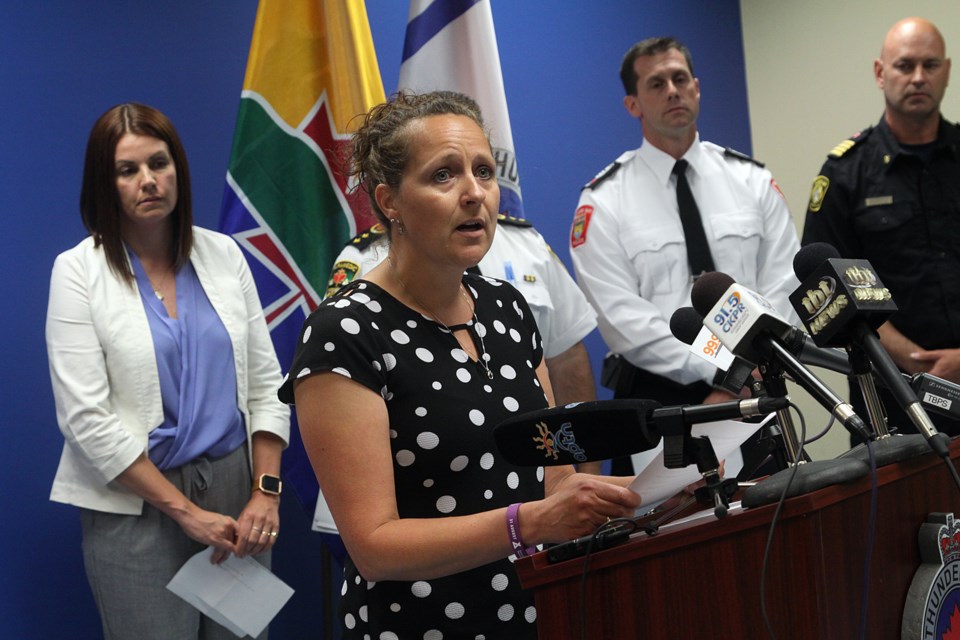THUNDER BAY – The escalating number of opioid overdoses constitutes a community crisis, with fatalities increasing by 40 per cent in 2018 compared to the previous year.
Representatives from the city’s three emergency services, along with Thunder Bay Drug Strategy and Thunder Bay District Health Unit officials, held a joint news conference on Wednesday to make the declaration.
Preliminary data released earlier this month by Public Health Ontario showed 44 opioid-related deaths in the Thunder Bay District last year, spiking from 31 the previous year. Nearly half – 19 – of the fatal overdoses happened during the final four months of the year.
“People are dying and this is avoidable,” said Thunder Bay Drug Strategy coordinator Cynthia Olsen.
In 2017, the city’s opioid death and emergency department visit rates were both more than double the provincial average, a trend that is expected to be higher last year when the statistics are finalized.
To combat the influx of southern Ontario gang activity bringing drugs, guns and human trafficking to Thunder Bay, local and regional policing agencies have teamed up to create a joint task force. That initiative, referred to as Project Disruption, in its first six months had seized drugs with an estimated street value of more than $1.5 million. That haul included more than one kilogram of fentanyl, an amount that is believed to be capable of causing 500,000 fatal overdoses.
Despite the series of busts having resulted in the apprehension of more than 80 confirmed or suspected gang members, the crisis is not a situation that police can arrest their way out of, said Thunder Bay police communications director Chris Adams.
“This isn’t just about law enforcement,” Adams said, acknowledging the call for help to all levels of government is not unique to Thunder Bay.
“This is about dealing with a real health and safety issue that needs broader help and support. You can only do so much, and quite frankly there has been quite a bit of downloading on municipalities to deal with many issues that sometimes are out of their scope financially.”
Thunder Bay Police Service Staff Sgt. Shawn Harrison said local opioid abuse includes fentanyl patches and medically prescribed pills, but more dangerous and potentially tainted substances are becoming increasingly prevalent.
“What we’re seeing, and it’s causing lots of concern, is the fentanyl and carfentanil,” Harrison said.
“It’s the fentanyl coming in and being sold that we have no idea what the purity of it is, the consumer or person purchasing it doesn’t know what the purity is. That’s where overdoses can occur, because they’re taking something in that they’re not too sure about and it’s poisoning them.”
In January 2018, health unit officials announced the first confirmed presence of carfentanil in Thunder Bay.
While Thunder Bay police have yet to lay homicide-related charges against anyone suspected of supplying drugs that led to a fatal overdose, Harrison said it has been considered.
“The issue is that once somebody dies of an overdose it’s a matter of trying to identify where they got the drugs from,” Harrison said. “One, the person that knew exactly where they got it from is no longer here to speak to us about it and sometimes friends or people that are with those people and privy are reluctant to give that information for fear incrimination, fear of giving up a source.”
Between July 2017 and June 2018, nearly 3,900 naloxone kits were handed out by the Thunder Bay District Health Unit and local pharmacies, representing the highest distribution rate in Ontario during that time. Naloxone is used to temporarily reverse the effects of an opioid overdose.
Thunder Bay paramedics responded to 176 opioid-related emergency calls through the first five months of the year. Emergency services collectively administering naloxone on 53 occasions.
“It’s just another call that adds to our already excessive call volume. It’s a high priority call for us, so it’s not something that sits in the queue and we get to it immediately,” Superior North EMS deputy chief Andrew Dillon said.
“We’re seeing our numbers of administration of naloxone increasing. We’re seeing a very large increase in the number of publicly administered naloxone. We don’t see any reason for that to change. When you talk about our call volume of about 33,000, 34,000 a year, 176 calls doesn’t seem like a lot but time-wise it’s a bigger proportion than it might seem.”
Emergency services are aware of bystanders administering naloxone in at least 81 cases from January through May.
Dillon, cautioning that naloxone is both a fast-acting but short-lived intervention, urged members of the public who administer it to continue to observe a person believed to be overdosing and have them seek further medical attention.
Thunder Bay has one of Ontario’s 15 approved consumption and treatment services sites, which Olsen said has been “very frequently used” since its initial opening last November.
There is no one silver bullet to address the crisis, Olsen said, stressing the importance of a multi-pillared approach that includes funding commitments for long-term prevention efforts.
“We’ve done lots of advances in our community, expanding or implementing new treatment options but they continue to be at or above capacity,” Olsen said. “That demonstrates that people are wanting to use and access these services but we unfortunately have to turn people away at times.”
